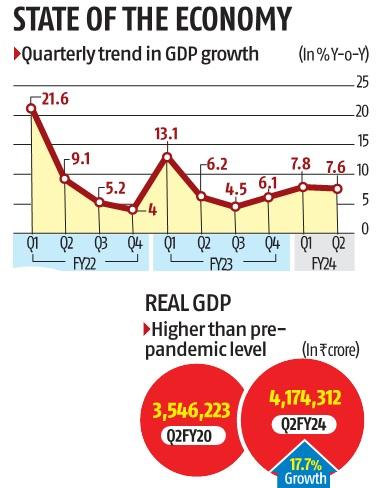
India’s GDP Expands 7.6 Per Cent In Q2; Manufacturing, Construction Lead The Charge

NEW DELHI: India’s gross domestic product (GDP) grew at 7.6 per cent in the September quarter of 2023-24, outperforming expectations by a wide margin as manufacturing and construction activities expanded by double digits. These figures signalled that economic recovery was well underway in Asia’s third-largest economy, despite the current adverse geopolitical situation.
While the Reserve Bank of India (RBI) had projected GDP growth of 6.5 per cent for the second quarter of FY24, a Reuters poll of economists estimated it to be slightly faster, at 6.8 per cent.
“The GDP growth numbers for Q2 display the resilience and strength of the Indian economy in the midst of such testing times globally. We are committed to ensuring fast-paced growth to create more opportunities, rapid eradication of poverty and improving ‘Ease Of Living’ for our people,” Prime minister Narendra Modi posted on X.
Data released by the National Statistical Office (NSO) showed a robust nine-quarter high growth in the manufacturing (13.9 per cent) and construction (13.3 per cent) sectors. However, this was offset by a steeper slowdown in services activity.
The strong growth in manufacturing was driven by a surge in listed company profits, supported by a rise in volume growth and an improvement in profit margins due to continued deflation in input prices. The robust growth in the construction sector reflected the front-loading of capex by the Centre and state governments.
The slowdown in the services sector to a six-quarter low was driven by the trade, hotels, transport, and communication services sub-sector (growth of just 4.3 per cent), which is the largest contributor to GDP.
Despite this, with 17.7 per cent growth over the second quarter of FY20, the sector exceeded the pre-pandemic levels, after falling short in the first quarter of FY24. Other services sub-sectors, such as financial and real estate (6 per cent) and public administration and defence (7.6 per cent), also saw a significant slowdown in activity, despite robust credit growth and a pick-up in government spending.
In the first half (April-September) of FY24, the economy grew at 7.7 per cent, with 7.8 per cent growth in the June quarter. To meet the full-year estimate of 6.5 per cent by the central bank, the economy needs to grow at 5.3 per cent in the second half (October-March) of the financial year. Considering the RBI’s growth forecasts for the third and fourth quarters at 6 per cent and 5.7 per cent, respectively, annual growth in FY24 could reach 6.7 per cent.
Crisil’s chief economist D K Joshi said that despite a moderation in the second half, India is expected to outperform other large economies this financial year. “We still expect growth to slow in the second half due to a deepening global slowdown; the lagged impact of domestic rate hikes manifesting fully through the second half of this fiscal; and erratic weather and an El Niño event creating some downside to agricultural growth prospects,” he explained.
The agriculture sector’s growth in the September quarter was weighed down by a weak and erratic monsoon, resulting in the slowest expansion in the past 18 quarters — at 1.2 per cent. Sunil Kumar Sinha, principal economist at India Ratings, said: “The below-par growth in the agriculture sector implies that rural demand is under stress, which is preventing the consumption demand from being broad-based. This is adequately reflected in the subdued sales of FMCG products in rural areas.”
During the September quarter, the gross value added (GVA) at basic prices grew 7.4 per cent, while nominal GDP was up 8 per cent due to low wholesale price inflation. In the April-September period, the nominal GDP grew at 8.6 per cent, against the full-year budget estimate of 10.8 per cent.
“Despite the likelihood of nominal GDP growth being close to 9 to 9.5 per cent for FY24, the higher direct tax buoyancy would make up for any shortfall due to this lower nominal growth. We expect the central government to adhere to its fiscal deficit target of 5.9 per cent of GDP for FY24 in the forthcoming Interim Budget,” said D K Srivastava, chief policy advisor at EY India.
Growth in private final consumption expenditure, or private spending, slowed down to 3.1 per cent due to continued distress in rural demand. Government spending, however, picked up and grew at 12.4 per cent in real terms, signalling that both Central and state governments expanded their public expenditure. Gross fixed capital formation (GFCF), which represents investment demand in the economy, grew at 11 per cent— a five-quarter high — because of the frontloading of capex by the government.
Export of goods & services grew 4.3 per cent in the second quarter as against a contraction of 7.7 per cent in the previous quarter, indicating resilience in services exports growth despite adverse geopolitical situation.
Source: Business Standard
The post India’s GDP Expands 7.6 Per Cent In Q2; Manufacturing, Construction Lead The Charge first appeared on Latest India news, analysis and reports on IPA Newspack.



